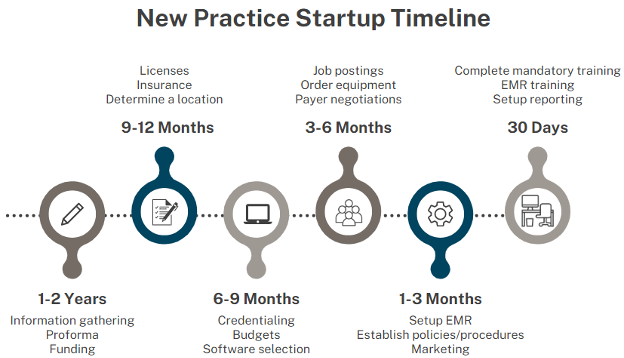3 min read
A Roadmap for Success: Opening a New Medical Practice
Julie Hardy : Jun 19, 2023 1:47:10 PM

While opening a new practice is certainly possible, it can feel like it requires superhuman effort. Therefore, opening a new practice doesn’t happen overnight. It can take years. This blog outlines some of the high-level, but often overlooked steps of opening a new medical group.
These steps are applicable whether you’re expanding a currently established practice or starting from scratch. The timeline is fluid and may be adjusted based on independent situations. Practices that are expanding don’t need as much lead time as a practice that’s starting from scratch. Use the steps below as a guide and adjust as needed for your practice.
12-24 Months Pre-Opening
In this planning phase, be sure not to lose sight of recruitment, especially if this is a PE-backed initiative. When selecting a location, you’ll want to take into consideration the demographics of the region, potential referral sources in the area, and local hospitals in addition to the competition in your specialty.
- Physician recruitment
- Proforma/value analysis
- Develop contracts, conflict of interest, and confidentiality agreement
- Choose a location
- Contract with consultants and vendors as needed
- Obtain funding
9-12 Months Pre-Opening
Now is the time to kick the administrative legwork into high gear. In addition to the necessary paperwork, research should be conducted related to the services that will be provided at your practice. Depending on your specialty, it’s important to consider patient-pay services that align with your practice such as Botox and specialized physical therapy.
- Establish trade name/DBA
- Obtain tax ID/EIN
- Obtain malpractice insurance
- Apply for licenses
- Business, DEA, state medical licenses, equipment, etc.
- Lease or purchase a location
- Office buildout
- Obtain FMV appraisal, if needed
- Setup banking
6-9 Months Pre-Opening
In addition to hospital privileges, consider if you’ll need a hospitalist group to round on patients from your practice who are admitted. When purchasing equipment, including lab equipment, ultrasounds and other clinical necessities, also consider computers, tablets, phones, etc.
- Hospital privilege applications
- Establish capital and operating budgets
- Determine equipment needs
- Develop job descriptions
- Provider contracting
- Identify payers with which you’ll contract
- Credentialing
- Determine if you’ll outsource any functions
- Select an EMR
3-6 Months Pre-Opening
This is the point at which you’ll start hiring key staff that you need on board in advance to help the practice prepare for opening. Your practice manager should not start the same day your practice opens! Those who need to establish EMR and clinical workflows should also be hired at this point.
- Job postings for administrative and support positions
- Hire practice administrator/manager, HR director, CFO, COO, etc. early
- Purchase software
- Obtain lock box
- Join local/state medical societies
- Submit payer applications/negotiations with payers
- Establish marketing plan
- Order computers, phones, and other office equipment
- Determine operating hours
1-3 Months Pre-Opening
As your systems are getting setup and associated processes are established, be sure you’re establishing internal controls (i.e., division of responsibilities) to protect your practice from fraud and abuse. The most time-consuming step in this phase is to setup the EMR, and critical staff should be involved with establishing these workflows.
- Setup payroll system
- Establish all accounting and reporting systems
- Establish compliance plan, internal controls
- Implement marketing plan
- Setup EMR
- Schedules, templates, workflows, charging, dashboard, etc.
- Order reference materials
- Request access to hospital EMRs, if needed
- Setup e-prescribing in EMR
- Document operating procedures
- On-call, sample medications, ordering, notifying patients of results, etc.
30 Days Pre-Opening
As opening day gets closer, most staff should be hired, and training should take place. This will include training related to general policies, safety, the compliance plan and the EMR. This is also when you’ll start scheduling appointments for the first days and weeks the practice is open.
- Complete OSHA, HIPAA, and compliance plan training
- Train staff on EMR
- Set daily/weekly/monthly reporting needs
- Publish website
- Make patient appointments
7 Days Pre-Opening
In addition to ensuring the providers know how to document within the EMR, they also need to have a solid understanding of the documentation and coding guidelines. Any superbills or encounter forms should be approved by both the providers and the coding/billing staff. Keep in mind that at this time, you’ll also be troubleshooting anything that goes wrong, and a lot will probably not work as expected!
- Documentation and coding review with providers
- Finalize superbill/encounter form, if needed
- Post all notices required by city, state, OSHA, etc.
- Prepare consents, HIPAA privacy notices and other documents that may be physically presented to patients
- Inform all patients scheduled the first week to arrive early
Day One
Depending on marketing and scheduling, the first day may actually be surprisingly quiet! A well-prepared practice will have a fairly quiet first day. Start looking for what’s not working in your practice, whether it’s related to scheduling, a process or even the physical placement of equipment.
- Have IT available
- Observe all processes
- Provide additional training as needed
- Run all reports early
- Start establishing dashboards
30 Days After Opening
Bad habits happen fast, so be sure you’re combatting bad habits, such as unnecessary workarounds, as quickly as possible to keep your practice running efficiently in the future. Put the onus on staff to identify opportunities to improve. Focus on eliminating paper and manual processes as much as possible.
- Have medical records and billing audited
- Verify all staff training and orientation was completed
- Reconcile all payer payments for accuracy
- Monitor workflow for opportunities to improve
Remember, opening a new practice can be tough and time-consuming. While this isn’t an exhaustive to-do list, it’ll help you get started on the right foot.
